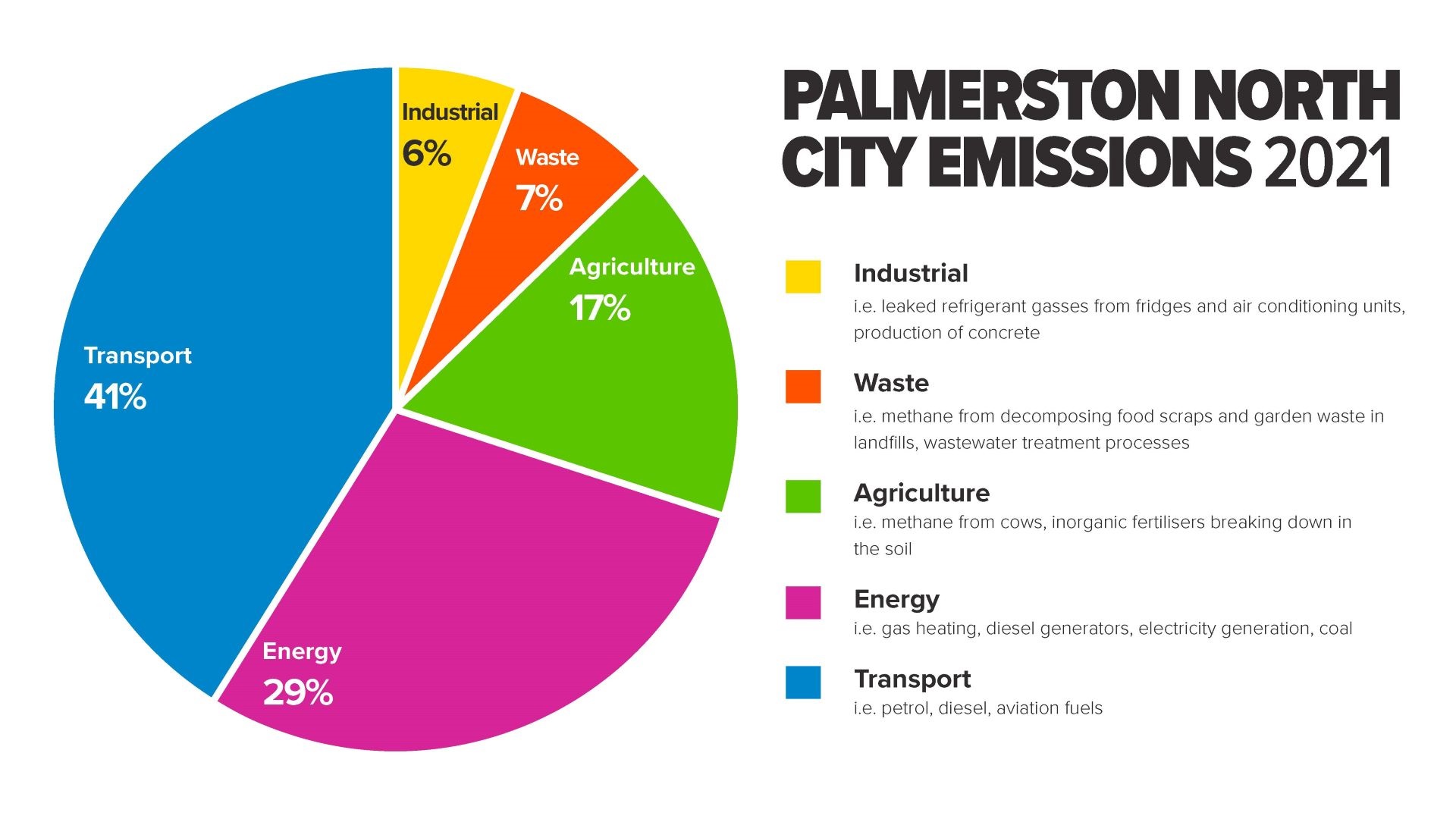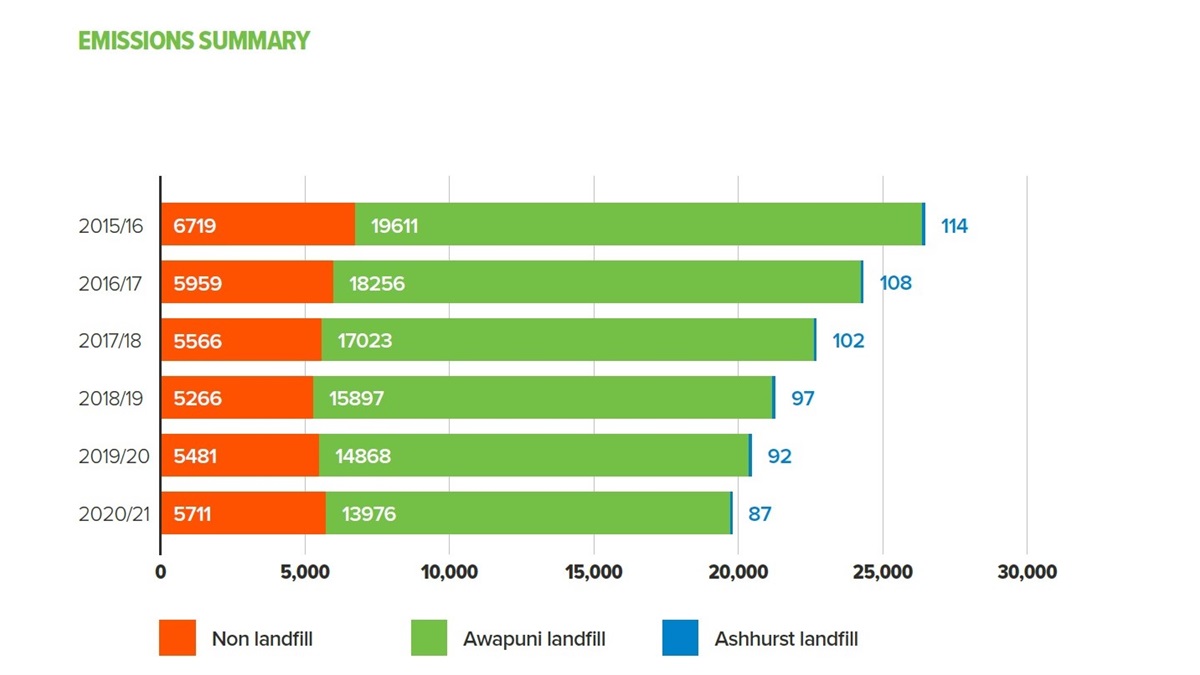A central part of our goal to be an eco-city is achieving a 30% reduction in Palmy’s greenhouse gas emissions by 2031. This target is our part of a national effort to make the whole of New Zealand carbon neutral by 2050.
As part of a worldwide effort to keep global warming to +1.5 degrees or less, the New Zealand government declared a climate emergency in December 2020. This triggered programmes like the Emissions Trading Scheme and the National Emissions Reduction Plan.
There is now a sustained national effort to get to net zero carbon emissions across Aotearoa by 2050. Put simply, net zero means cutting greenhouse gas emissions to as close to zero as possible, with any remaining emissions re-absorbed by natural sources like forests.
This effort will require real action across every sector of New Zealand’s economy. It means Council will need to find ways to significantly lower our own emissions. We’ll also need to use our regulatory powers to encourage others to lower theirs. We adopted many of the principles of the government’s net zero plan in our Eco City Strategy and Climate Change Plan.
Meeting this target is not something Council can do alone. It’s only with widespread buy-in and effort from our community that Palmy will be able to create a climate-resilient future with cleaner air and energy, better transport options and healthier homes.
What the government is doing about climate change | Ministry for the Environment
Recent changes in our local weather patterns have indicated some of the ways Palmerston North and the wider district may impacted by climate change. Regional reports on the estimated changes and possible flow-on effects can help us understand and plan for the future.
While Manawatū District has less populated areas of coastline to defend against coastal erosion than many other districts, we still have plenty of water around!
One estimated impact of climate change for our region is that more heavy rainfall will increase the risk of flooding, making it up to four times as frequent by the end of the century. This could have large implications for areas already prone to river flooding, like the Manawatū and Rangitikei flood plains.
Because our region has diverse landscapes, other areas will probably see more droughts. Both these aspects are likely to increase erosion, slips and landslides.
The National Institute of Water and Atmospheric Research (NIWA) has prepared a report on likely impacts of climate change for the Manawatu-Wanganui region.
Horizons has collaborated with other councils in the region to produce a regional risk assessment and climate action strategy.
Manawatū-Whanganui regional climate change risk assessment | Horizons Regional Council
Climate action strategy | Horizons Regional Council
Keeping an annual record of our annual emissions across the city allows us to measure how our progress compares to our eco city targets.
Transport is by far Palmy’s largest carbon contributor. Nearly half our citywide emissions are transport related. Meeting our carbon goal will rely heavily on helping people to drive a lot less.
Forestry has also had a large effect on the carbon levels for Palmy city. Citywide emissions rose by approximately 80,000 tonnes between 2020 and 2021 year with the recent cutting down of mature pine trees in surrounding areas accounting for 68,000 of this increase.
Growth in our population will mean increases in demand for goods and services. New technologies, incentives, regulatory changes and cleaner options will all play their part in using our resources more efficiently to help Palmy grow sustainably.
Last year’s inventory of Palmy’s carbon emissions is below.

To help Palmy reach its carbon reduction targets we need to do our part by reducing greenhouse gas emissions from Council's own activities.
Since we first began monitoring in 2016 Council has reduced our annual emissions by 6,004 tonnes carbon dioxide equivalent (tCO2e), or 22.7%. It’s a good start. But if we’re to meet our target of 30% emission reduction across the city by 2031, we’ll need to drive our own efforts forward at pace and encourage behaviour change within our community as well.
To continue cutting our Council emissions our elected members have created a low carbon fund, which invests $1 million a year in lowering carbon outputs from our operations. So far, we’ve used this toward more efficient streetlights, boilers, systems at the Lido and electric pool cars for our officers.
The chart below shows Council's carbon emissions from 2016 to 2021.

Our climate change team is always looking into what other low carbon technologies and processes we can adopt in our mission to lower our carbon use as much as possible.
To see how we’re tracking across different areas of our operations check out our eco city dashboards.
There are heaps more examples of ways we’re working to reduce our carbon footprint and look after our environment in our environmental sustainability review.
Understanding where your emissions are coming from is important to figuring out what changes you could make to reduce them. Fortunately, there are some great tools available to help!
Household
Auckland Council has developed an easy-to-use household carbon calculator to help you figure out your weekly footprint. Get started at FutureFit.nz
Then check out the rubbish and recycling section of our website. We've got heaps of tips to reduce your waste.
Food waste breaking down in our landfills is a significant contributor to damaging methane emissions. Find tips and recipes to help you reduce your food waste on the Love Food, Hate Waste website
The government's hub for climate action and ideas provides tips, tools and everyday examples of how other Kiwis are taking action on climate change. Check it out at GenLess
Business
Is your business looking for tools and strategies to reduce your carbon footprint, save money and be more energy-efficient?
Check out these two websites:
Toitū Envirocare
Ekos
Community
We support a number of fantastic organisations around Palmy with volunteers who are working hard to look after our natural environment and build resilience against climate change. One of the most practical and effective ways to make a difference yourself is to get involved!
Community action
Community planting
Environment Network Manawatū